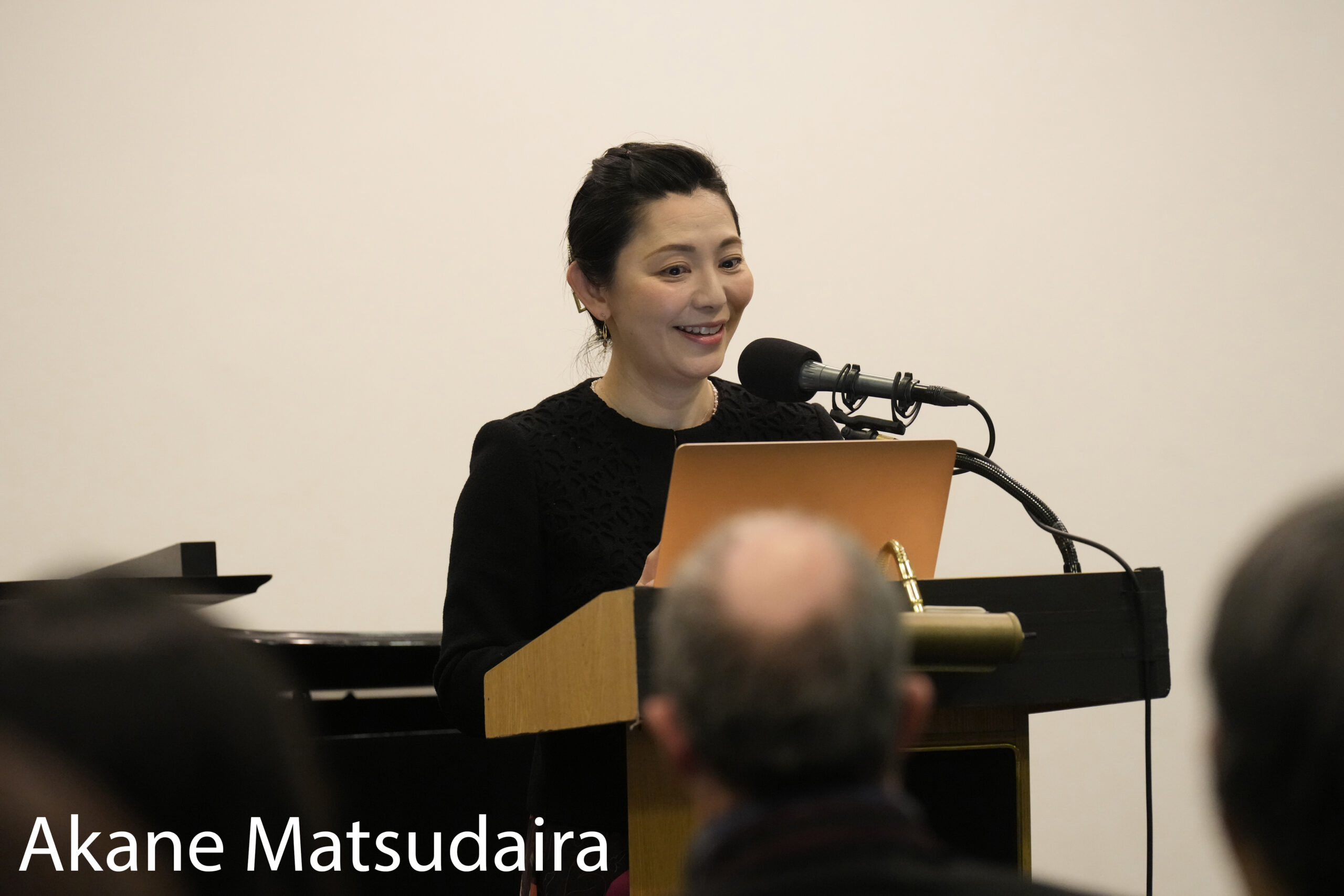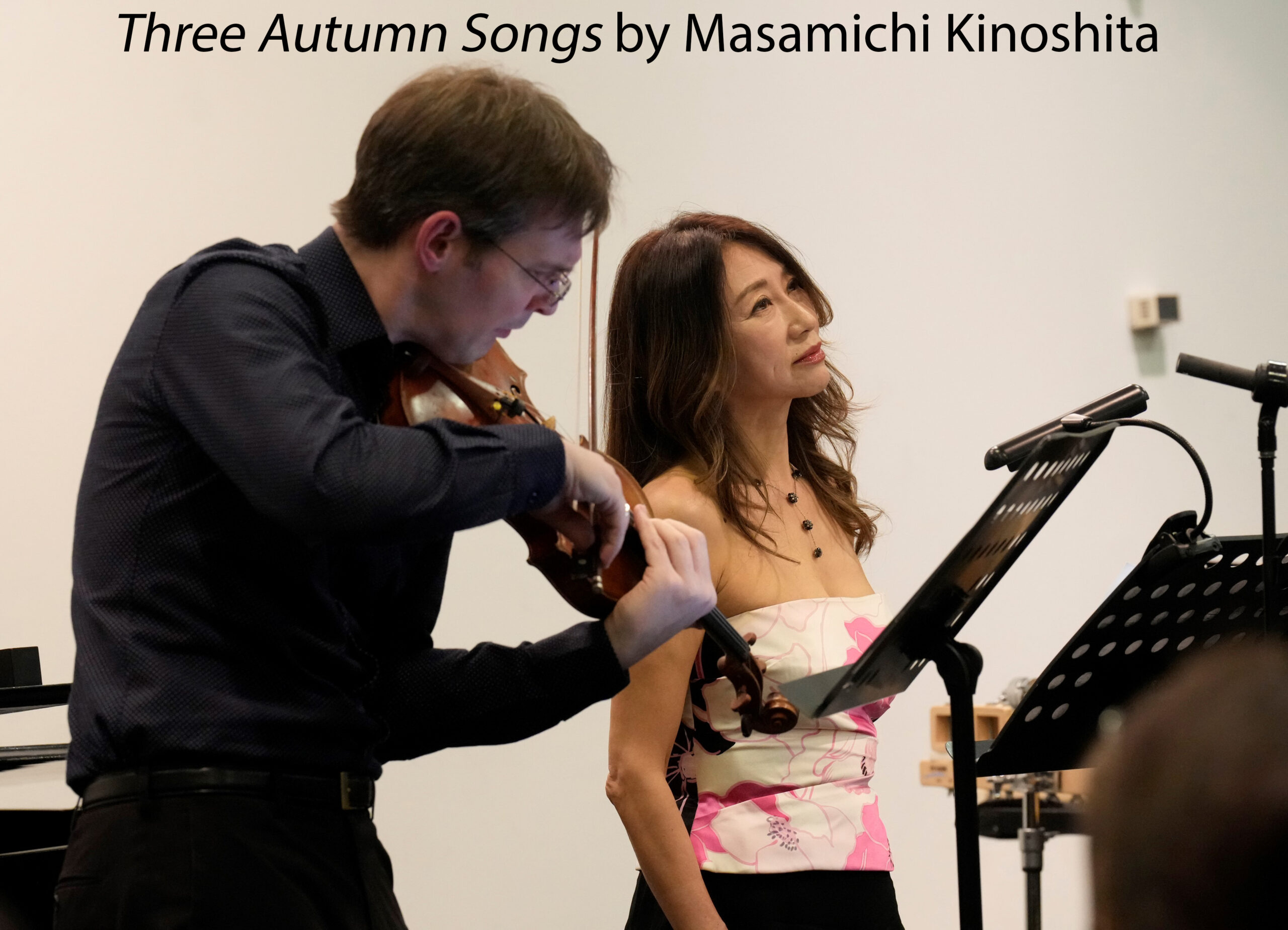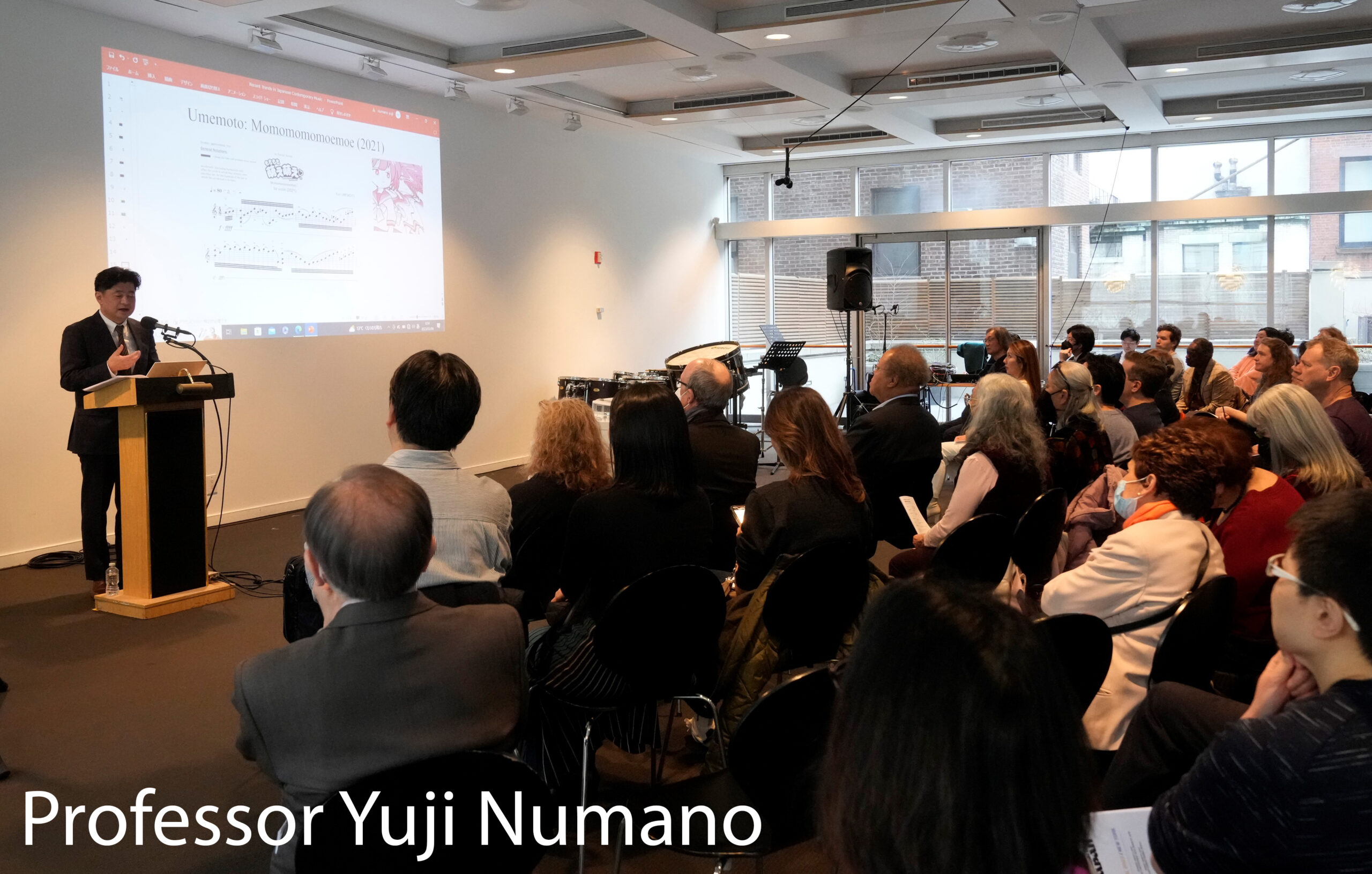
Saturday, March 4: COLORS: Contemporary Vocal Works of Japan
Sunday, March 5: Current Sounds Japan III
Music From Japan Festival 2023 New York Program
The two concerts comprising the main event of Music From Japan Festival 2023 New York, 48th Season and Eighth Artist Residency showcased the breadth and craftsmanship of Japanese music today. The first concert, “COLORS: Contemporary Vocal Works of Japan”, featured a program of vocal works assembled by curator and music critic, Akane Matsudaira. The second concert, “Current Sounds Japan III”, brought three Japanese composers to the festival for the American premiere of recent works from their respective catalogs along with the world premiere of works commissioned by Music From Japan for the occasion. The composers – Akira Ito, Madoka Mori and Yoshihiro Kanno – drew inspiration from musicology, sociology, ritualistic music and more, culminating in captivating and eclectic work. Both concerts were performed by some of the most impressive players from New York’s contemporary music world – preceded by informative lectures and followed by an open Q&A or forum with performers and/or composers.
COLORS: Contemporary Vocal Works of Japan
On Saturday, March 4th, 2023, the opening concert of Music From Japan Festival 2023 New York commenced with a talk by Akane Matsudaira titled, “Contemporary Vocal Works of Japan – from a singer’s perspective.” As a renowned soprano in her own right (as Akane Kudo) she was uniquely equipped to shed light on myriad salient points – regional Japanese vocal musics, lyrical content on the concert program, notational systems and even sumo wrestling. The eclectic program that Ms. Matsudaira assembled showcased a diverse and rigorous glimpse of Japanese vocal music’s vibrancy – grappling with such questions as the legacy of serialism, the setting of haiku and translation – all the more enjoyable after her illuminating talk.
The first piece on the program was Mari Takano’s Two Chansons, for soprano and piano. Composed in 1997, the piece stems from literary inspiration (Graham Greene’s The End of the Affair and N.P. by Banana Yoshimoto for each half of the piece, respectively). The work utilizes repetition of particular notes in the vocal part – performed by soprano Wonjung Kim – as direct allegories for lingering thoughts and feelings regarding a past love. This repetition is contrasted, supported and even overshadowed at times by the piano part, played by Rieko Aizawa. Though the work continually returns to its repetitive nature, the music is increasingly abstracted in favor of movement and modulation until the end of the piece.
Second on the program was Etudes Lunaire, by Motoharu Kawashima – the performance of this work, along with the remainder of the program, was an American Premiere. Etudes Lunaire works as a kind of refraction of Arnold Schoenberg’s seminal piece, Pierrot Lunaire. Mr. Kawashima used the raw elements of Schoenberg’s work, specifically the formal significance of the number 21, to define the vocabulary of his piece. The result is 21 distinct vocal techniques that are arranged and sung disjointedly, in an “extreme and condensed manner.” Akane Kudo delivered an electric performance of the piece.
Rica Narimoto’s work, The Sound of Water from Basho’s Haiku, was third on the program. Completed in 2012, the piece was first conceived as a musical setting for text from Japanese haiku. After conducting exhaustive research into possible haiku to draw from, Ms. Narimoto decided to feature the work of the renowned poet, Basho (1644-1694). Taking it one step further, she translated the text into English herself, resulting in an interpretation bespoke to the expressive impact of Basho (as she felt it) and the musical effect she hoped to have as a composer. The text was delivered exquisitely by the American bass-baritone, Michael Kelly.
After a brief intermission, the concert continued with Three Autumn Songs b (2nd & 3rd sections only) by Masamichi Kinoshita. This duet was composed as a tribute to Masanori Taki, a calligraphy artist of particular importance to the community around the Takefu International Music Festival in Echizen City, near Mr. Kinoshita’s hometown. The original instrumentation, however, was for mezzo-soprano and flute – before several alternative versions for various instrumentations were produced, such as the one for mezzo-soprano and violin featured on this concert. Wonjung Kim delivered the text, sourced from three poems by Jukichi Yagi, with the necessary balance of expressiveness and solemnity to evoke the intended tone of late autumn. This tone was beautifully supported by Jesse Mills’ nuanced interpretation of the spacious, contrapuntal violin part.
The next piece, Hiroyuki Yamamoto’s Umi-no Mieru Fukei (The Landscape with Ocean View), featured Ms. Kim again, this time in another duet with pianist Rieko Aizawa. Inspired by the sea poetry of Yukari Kojima, Mr. Yamamoto composed a poignant work with succinct use of materials. Setting four different poems to the same melody in the vocal part, the piece highlighted the changes in color and mood by placing each poem against the same pitch-material. This effect was augmented by the piano accompaniment, which varied greatly from setting to setting.
The program continued with a piece by Sachiyo Tsurumi, entitled Kamoshika. Deconstructing the word, “kamoshika”, Ms. Tsurumi chose particular characters to imbue it with a dual meaning – one being a gazelle and the other a nuanced expression of a particular sake and a spiritually-infused notion of its brewing. With these meanings in mind, she composed a work that alternated between tones that might be associated with those meanings; a more driving section, evoking the speed and buoyancy of a gazelle, followed by a gracefully somber, slow and undulating section. Given the feeling of the piece, it is not hard to see why it was originally arranged to include dance.
Fittingly, the concert finished with a vocal duo – Recitativo and Aria by Yoriaki Matsudaira (1931-2023). Originally commissioned by Akane Kudo and Takashi Matsudaira, this work was conceived as a re-structuralist approach to an old-fashioned form. The piece utilizes Japanese, French and German, deconstructing the grammar of each towards a result the composer described as an “anagram” of all three. Despite the classical implications of the title, Recitativo and Aria presented the audience with a dazzlingly playful (not to mention extremely challenging to perform) piece of music. Sadly, Mr. Matsudaira passed away shortly before this American premiere of the work; the performance was dedicated to him.
“COLORS: Contemporary Vocal Works of Japan” was concluded with a thought-provoking Q&A with all three singers from the concert – hosted by Matthias Kriesberg.
CURRENT SOUNDS JAPAN III
The second concert of the festival took place on Sunday, March 5, 2023 and featured the work of three artists whom Music From Japan awarded its Eighth Artist Residency. Yoshihiro Kanno (Chairman of The Japan Federation of Composers), Madoka Mori and Akira Ito were each commissioned to compose one new work for this program, to be played along with another from their existing body of work. The concert was preceded by a lecture by Professor Yuji Numano from Toho Gakuen School of Music, titled “Recent Trends in Japanese Contemporary Music”, which spotlighted four Japanese composers (each from a different generation) actively working today. Such topics as robotic performers, coding as source material for music, A.I. utilization and popular music’s influence were discussed along with audio samples.
The first half of the program featured the American premieres of each composer’s selected work. Madoka Mori’s Vocalise (2018) for cello solo – performed by Christopher Gross – was originally conceived as an encore for her cello concerto, Atrium. Utilizing the inherent harmonic language of the cello and an equal use of both pizzicato and arco articulations, Ms. Mori was able to work with explicitly melodic material in a style that both subverts and features the more traditional vocal approach to melodic playing suggested by the title and often associated with the cello.
Next came Yoshihiro Kanno’s work for piano and Nambu bell (made of cast iron from Nambu), titled A Particle of Light (2009). The piece showcases the full range of the piano, with a slow pulse and a palette that’s more harmonic (even textural) than melodic. A Particle of Light has a symbolic meaning that plays out formally as the work progresses. In his liner notes, Mr. Kanno draws a parallel between the iron materials used to make both the bell and the piano strings, but makes a distinction between their Japanese and Western origins, geographically and culturally. This framing adds a depth of meaning to the interplay between these two ‘iron sounds’.
Third on the program was Akira Ito’s Even a Chance Acquaintance is Decreed by Destiny (2021), a trio for cello, accordion and bass clarinet inspired by (as the name would suggest) the potential long term effects of even the most banal social interactions. In Mr. Ito’s liner notes for the piece, he says “this work is a careful consideration of the elements of sound and their relationships from multiple viewpoints”, and that social framing of the material comes through in the music. Complex multiphonics, spectral gestures, sharp attacks and more are constantly re-arranged in relation to one another, evoking a kind of sonic collage rather than a more familiar linear form.
The second half of the concert showcased the newly commissioned works by each composer, all of which were world premieres. Madoka Mori’s piece, Prologue for string quartet was first. Again, she took inspiration from a traditional title to expound upon and stretch the typical meaning it carries. In this case, Ms. Mori is pondering the threshold that has been crossed as a society in our collective experience of the COVID-19 pandemic, and has reflected that sense of something new changing the inherited world (that we are in the prologue to a new era). More specifically, this meant using triadic harmonizations of the piece’s core motif in innovative and subversive ways – new uses of older materials. The result is a piece of music both eerily familiar and surprisingly fresh at the same time.
Next on the program was Akira Ito’s piece for string quartet, The Strength of Weak Ties. In keeping with his sociological interest, Mr. Ito took titular inspiration for this work from Mark S. Granovetter’s 1973 paper of the same name (he also noted that this work is an extension of the ideas explored in Even a Chance Acquaintance is Decreed by Destiny). Using Granovetter’s notion – of the potentially greater power that weak social ties have over more familiar ones to bring unexpected and life-altering information into our lives – as a formal jumping off point, he composed a compelling work where the relationships between what each member of the string quartet is playing oscillates between total unity and stark juxtaposition.
Both Prologue and The Strength of Weak Ties were performed by Momenta Quartet.
The final piece of the concert was Imaginary Ritual by Yoshihiro Kanno. Using the rhetorical rhythms and tones from a particular Sanskrit incantation as the basis for the work, Mr. Kanno sought to create an “imaginary ritual raising ‘Prayers to the Stars’”. Written for a quintet featuring piccolo/alto and standard C flute, bass and Bb clarinet, violin, cello and percussion, Imaginary Ritual establishes a rhythmic unison within the ensemble that is maintained throughout much of the piece. When combined with the heft of the bass clarinet and the thematic insistence of the flute part (reflected elsewhere in the ensemble), the cumulative sound indeed does establish a ritualistic environment, suggestive of something ulterior.
Similar to the first night of music, CURRENT SOUNDS JAPAN III was followed by an open forum with the commissioned composers, Professor Numano and Momenta Quartet’s violist, Stephanie Griffin – moderated by George E. Lewis. They discussed topics such as “Japanese-ness” in music and noise while fielding questions from members of the audience.
Nina Fukuoka served as interpreter for both post-concert events.




















